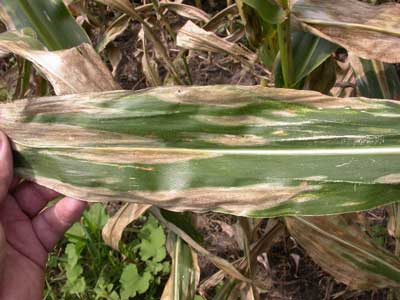
Northern corn leaf blight is being reported from Minnesota to Kentucky, and east, but particularly from central and northwestern Iowa. Northern corn leaf blight (NCLB) has potential to reduce corn yield in susceptible hybrids or when infection occurs early. Significant leaf blighting above the corn ear by VT through R2 growth stages is most commonly responsible for yield loss.
There are multiple races of NCLB and there are also varying degrees of resistance in commercial hybrids. One field might be essentially free of NCLB, while the neighboring field is heavily blighted. This variability can complicate both diagnosis of the disease and also the decision of whether or not to apply fungicides.
Northern corn leaf blight infection is favored under moist conditions (especially heavy dew), with temperatures between 65 and 78 With classic NCLB leaf symptoms, “cigar-shaped” lesions form parallel to the leaf veins. Borders of the lesions are distinct and well defined. These lesions can range from one to seven inches in length and the lesions may coalesce to blight extensive areas of the leaf surface. With susceptible hybrids, spore formation within the NCLB lesion causes the lesion to look dirty. Northern corn leaf blight seasonal infection is favored in fields with corn-following-corn and abundant corn residue, such as with no-till.
Northern corn leaf blight can be confused with other diseases, such as Goss’s wilt and Diplodia leaf streak. There are no good thresholds or treatment guidelines for this disease, so we use the following default guideline: With susceptible hybrids, under good environmental conditions for NCLB infection, consider fungicide application when lesions are easily noted one or two leaves below the ear leaf by just before tassel emergence.